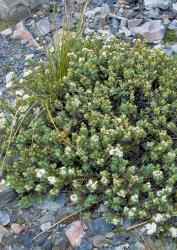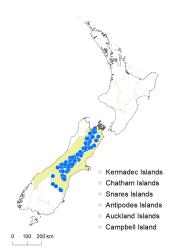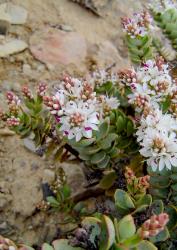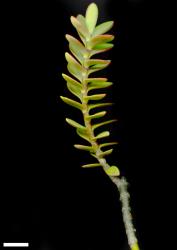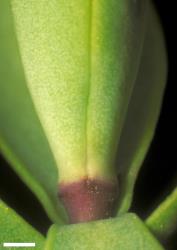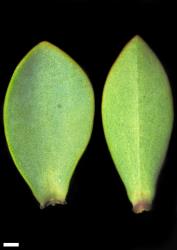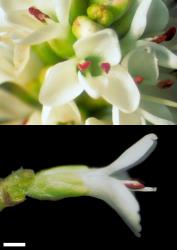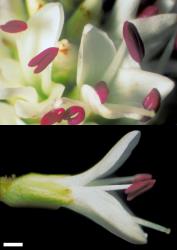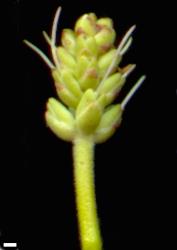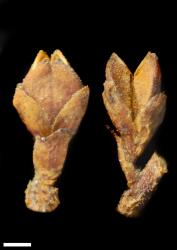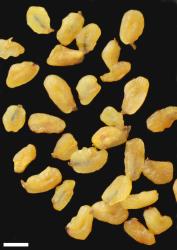- ≡ Hebe pinguifolia (Hook.f.) Cockayne & Allan, Trans. New Zealand Inst. 57: 36 (1926)
Spreading low shrub to 0.8 m tall, usually less. Stems decumbent to erect, eglandular-pubescent; hairs bifarious, sometimes sparse. Leaf bud distinct, its leaves appressed at margins until fully grown; sinus usually absent, rarely very small, acute to rounded. Leaves opposite-decussate, sometimes sub-distichous on spreading branches, erecto-patent to spreading; lamina coriaceous, lanceolate (usually broadly), ovate, elliptic, or obovate, 7–22 mm long, 4–12 mm wide, dull glaucous or glaucescent above and beneath; midrib obscure, slightly raised beneath; surfaces glabrous; margin glabrous, entire, often minutely papillate; apex sub-acute to rounded; base cuneate or abruptly cuneate; petiole absent. Inflorescence a lateral spike or raceme, 10–34 mm long; flowers crowded, 12–22 (rarely as few as 4), female or bisexual on separate plants, ⚥ > ♀; bracts opposite-decussate, often becoming alternate above, narrowly ovate to deltoid, = or slightly < calyx; pedicels absent or 0–8 mm long, eglandular-hairy all around. Calyx lobes 4, sub-acute to obtuse, 2.5–3.0 mm long, sub-equal or equal, mixed glandular- and eglandular-ciliolate. Corolla 5–10 mm diameter; tube white, 2–3 mm long, = or slightly > calyx, glabrous; lobes 4, white, erecto-patent to recurved, sub-equal, elliptic to broadly ovate, 3–5 mm long, sub-acute to rounded; nectar guides absent. Stamen filaments white, 4–5 mm long; anthers pink to magenta; staminodes of ♀ flowers 2.8–3.5 mm long. Style eglandular-hairy at base, 5–8 mm long. Capsules latiseptate, obtuse to rounded, eglandular-hairy, 3.0–4.5 mm long, 2.5–3.2 mm at widest point. Seeds ellipsoid to oblong, flattened, finely wrinkled, pale brown or brown, 0.9–1.9 mm long.
Characteristic features of Veronica pinguifolia include the dark, reddish-black stems (grey when older), which contrast with the dull, bluish, glaucous and waxy leaves, often with red, sometimes yellow, margins. The stem pubescence is bifarious and the hairs are short (becoming glabrous on older stems. The capsule and base of the style are hairy.
Several other species characterised by glaucous leaves and short inflorescences of sessile flowers where the peduncle is about = the rachis might be confused with V. pinguifolia.
V. amplexicaulis plants differ by their broader, stem-clasping leaf bases, longer, shaggy hairs (0.3–0.5 mm long), and often glabrous stems except sometimes for a few long hairs adjacent to the leaf margins.
V. pareora plants have larger stature, strictly glabrous stems and peduncles, amplexicaul leaf bases, shortly pedicellate flowers, and glabrous capsules.
V. buchananii plants are very similar in many respects and sometimes hard to distinguish from V. pinguifolia, but generally they are smaller, often mat-forming, have smaller leaves that are keeled and glaucescent rather than glaucous, thick, corky stems, and longer cilia on bracts and calyx. Plants on the Black Birch Range (Marlborough) very closely resemble V. buchananii, but are included here in V. pinguifolia on the basis of short cilia on the margins of bracts and calyx and the distributions the two species otherwise exhibit (Bayly & Kellow 2006).
In the northern part of its range (east Nelson and north Marlborough), plants of V. pinguifolia sometimes have a small sinus in the leaf bud. These plants might be confused with V. baylyi, but V. baylyi plants are usually more erect, have glaucescent rather than glaucous leaves with a longer and tapering sinus in the bud, and glabrous capsules.
South Island: Sounds Nelson (Bryant Range, Richmond Range), Marlborough, Canterbury, Westland (Nelson Lakes National Park only), Otago (Hawkdun Range, Kakanui Mountains).
Alpine, open rocky and scree sites, east of the Main Divide, usually on greywacke, sometimes in grassland. Recorded elevations range from 549 to 2135 m.
Flowers: December–February (rarely to April); fruits: January–April.
2n = 40, 80 (see Bayly & Kellow 2006, as Hebe pinguifolia). Most plants studied had 2n = 80. Some plants matching V. pinguifolia from higher altitudes in South Canterbury (especially Mt Peel, Four Peaks Range, Mt Winterslow, Mt Somers) had 2n = 40 (see Bayly & Kellow 2006for details).
Veronica pinguifolia is classified in V. subg. Pseudoveronica sect. Hebe and the informal group “Subcarnosae” (Albach & Meudt 2010; Bayly & Kellow 2006). V. pinguifolia is one of many species whose relationships are not well resolved in recent DNA-based phylogenetic studies (e.g., Wagstaff et al. 2002). It is likely to be related to other species with small, glaucous leaves and short inflorescences of sessile flowers (e.g., V. buchananii, V. amplexicaulis).



